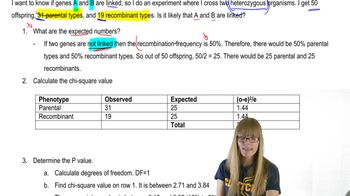Calculate the chi-square value for the above problem.
Table of contents
- 1. Introduction to Genetics51m
- 2. Mendel's Laws of Inheritance3h 37m
- 3. Extensions to Mendelian Inheritance2h 41m
- 4. Genetic Mapping and Linkage2h 28m
- 5. Genetics of Bacteria and Viruses1h 21m
- 6. Chromosomal Variation1h 48m
- 7. DNA and Chromosome Structure56m
- 8. DNA Replication1h 10m
- 9. Mitosis and Meiosis1h 34m
- 10. Transcription1h 0m
- 11. Translation58m
- 12. Gene Regulation in Prokaryotes1h 19m
- 13. Gene Regulation in Eukaryotes44m
- 14. Genetic Control of Development44m
- 15. Genomes and Genomics1h 50m
- 16. Transposable Elements47m
- 17. Mutation, Repair, and Recombination1h 6m
- 18. Molecular Genetic Tools19m
- 19. Cancer Genetics29m
- 20. Quantitative Genetics1h 26m
- 21. Population Genetics50m
- 22. Evolutionary Genetics29m
4. Genetic Mapping and Linkage
Chi Square and Linkage
Problem 13a
Textbook Question
Researchers cross a corn plant that is pure-breeding for the dominant traits colored aleurone (C1), full kernel (Sh), and waxy endosperm (Wx) to a pure-breeding plant with the recessive traits colorless aleurone (c1), shrunken kernel (sh), and starchy (wx). The resulting F₁ plants were crossed to pure-breeding colorless, shrunken, starchy plants. Counting the kernels from about 30 ears of corn yields the following data.

Why are these data consistent with genetic linkage among the three genes?
 Verified step by step guidance
Verified step by step guidance1
Step 1: Understand the problem setup. The researchers are studying three traits in corn plants: aleurone color (C1/c1), kernel shape (Sh/sh), and endosperm type (Wx/wx). The F₁ generation is produced by crossing pure-breeding dominant plants (C1, Sh, Wx) with pure-breeding recessive plants (c1, sh, wx). The F₁ plants are then test-crossed with pure-breeding recessive plants (c1, sh, wx). The data provided represents the phenotypes and their frequencies in the offspring.
Step 2: Recognize the concept of genetic linkage. Genetic linkage occurs when genes are located close together on the same chromosome, causing them to be inherited together more often than expected under independent assortment. If the three genes (C1/c1, Sh/sh, Wx/wx) are linked, the offspring phenotypes will deviate from the expected Mendelian ratios for independent assortment.
Step 3: Analyze the data for evidence of linkage. In the offspring, the phenotypes with the highest frequencies correspond to parental combinations (e.g., Colored, full, starchy and Colorless, shrunken, starchy). This suggests that the alleles for these traits are inherited together, consistent with genetic linkage. Recombinant phenotypes (e.g., Colored, shrunken, waxy) appear at much lower frequencies, indicating that recombination events between linked genes are less common.
Step 4: Consider the role of recombination. Recombination occurs during meiosis when homologous chromosomes exchange genetic material. The low frequency of recombinant phenotypes in the data supports the idea that the three genes are closely linked, as fewer recombination events occur between them.
Step 5: Conclude why the data supports genetic linkage. The observed phenotypic ratios deviate significantly from the expected 1:1:1:1 ratio for independent assortment in a test cross. The high frequency of parental phenotypes and low frequency of recombinant phenotypes are consistent with genetic linkage among the three genes (C1/c1, Sh/sh, Wx/wx).
 Verified video answer for a similar problem:
Verified video answer for a similar problem:This video solution was recommended by our tutors as helpful for the problem above
Video duration:
6mPlay a video:
Was this helpful?
Key Concepts
Here are the essential concepts you must grasp in order to answer the question correctly.
Genetic Linkage
Genetic linkage refers to the tendency of genes located close to each other on a chromosome to be inherited together during meiosis. This occurs because linked genes are less likely to be separated by recombination events. In the context of the corn plant experiment, the observed phenotypic ratios suggest that the traits are inherited together, indicating that the genes for colored aleurone, kernel shape, and endosperm type are likely linked.
Recommended video:
Guided course

Chi Square and Linkage
Phenotypic Ratios
Phenotypic ratios represent the relative frequencies of different observable traits in the offspring of a genetic cross. In this experiment, the ratios of kernel phenotypes provide insight into the inheritance patterns of the traits. By analyzing these ratios, researchers can infer whether the traits assort independently or are linked, which is crucial for understanding the genetic relationships among the traits.
Recommended video:
Guided course

Mutations and Phenotypes
Recombination Frequency
Recombination frequency is a measure of how often two genes on the same chromosome are separated during meiosis due to crossing over. It is expressed as a percentage and helps determine the distance between genes on a chromosome. A low recombination frequency between the genes for the traits in the corn plants would support the idea of genetic linkage, as it indicates that the genes are inherited together more often than expected by independent assortment.
Recommended video:
Guided course

Recombination after Single Strand Breaks

 7:33m
7:33mWatch next
Master Chi Square and Linkage with a bite sized video explanation from Kylia
Start learningRelated Videos
Related Practice
Multiple Choice
405
views
3
rank
